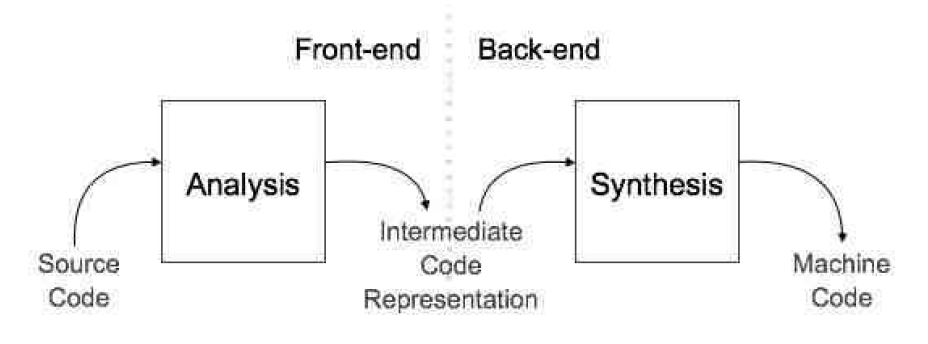Compilation process
This article is under construction :)
To be a good
programmer, you have to write a firmware that is readable, portable, and
maintainable and do the function required from it with the best usage of CPU
resources.
Understanding the
compilation process is a fundamental step to achieve the aforementioned.
Preprocessor
It is a tool that produces input for the compiler. It deals with file inclusion, macro processing and conditional compilation.
The purpose of this unit is to convert the C source file into pure C code file.
The purpose of this unit is to convert the C source file into pure C code file.
Compiler
The compiler take the pure C code and writes it in the form of assembly instructions. The compiler can be divided into two phases:
Analysis phase
Known as the front end of the compiler, it reads the source code, divides it into core parts and then checks for lexical, grammar and syntax errors.It generates an intermediate representation of the source program and symbol table, which should be fed to the Synthesis phase as input.
Analysis phase is divided into 3 levels: Lexical analyzer, Syntactic analyzer and Semantic analyzer.
Synthesis phase
Known as the back-end of the compiler, it generates the target program with the help of intermediate source code representation and symbol table.It is divided into 3 levels: Pre-Optimization, Code generation and Post-Optimization.
1- Lexical analyzer
It combines each characters in the source file to form a "TOKEN". A token is a set of character
that does not have 'space', 'tab' and 'new line'. Therefore this unit of compilation is also called
"TOKENIZER". It also removes the comments, generates symbol table, relocation table entries.
2- Syntactic analyzer
This unit check for the syntax in the code. For ex:{
int a;
int b;
int c;
int d;
d = a + b ‐ c * ;
}
The above code will generate the parse error because the equation is not balance. This unit
internal checks this by generating the parser tree as follows:
=
/ \
d ‐
/ \
+ *
/ \ / \
a b c ?
Therefore this unit is also called PARSER.
3- Semantic analyzer
This unit check for the meaning in the statements. For ex:
{
int i;
int *p;
p = i;
‐‐‐‐‐
‐‐‐‐‐
{
int i;
int *p;
p = i;
‐‐‐‐‐
‐‐‐‐‐
}
The above code generates the error as "Assignment of incompatible type". Therefore this unit
checks for such errors.
The above code generates the error as "Assignment of incompatible type". Therefore this unit
checks for such errors.
4- Pre-Optimization
This unit is independent of the CPU, i.e., there are two types of optimization
1. Pre-optimization (CPU independent)
2. Post-optimization (CPU dependent)
1. Pre-optimization (CPU independent)
2. Post-optimization (CPU dependent)
This unit optimizes the code in following forms:
I) Dead code elimination
II) Sub code elimination
III) Loop optimization
I) Dead code elimination:
For ex:
{
int a = 10;
if ( a > 5 ) {
/*
...
*/
} else {
/*
...
*/
}
}
Here, the compiler knows the value of a at compile time, therefore it also knows that the if
condition is true for ever. Hence it eliminates the else part in the code.
II) Sub code elimination:
For ex:
{
int a, b, c;
int x, y;
/*
...
*/
x = a + b;
y = a + b + c;
/*
------
*/
}
can be optimized as follows:
{
int a, b, c;
int x, y;
/*
...
*/
x = a + b;
y = x + c; // a + b is replaced as x:
/*
...
*/
}
III) Loop optimization:
For ex:
{
int a;
for (i = 0; i < 1000; i++ ) {
/*
...
*/
a = 10;
/*
...
*/
}
}
In the above code, if 'a' is local and not used in the loop then it can be optimized as follows:
{
int a;
a = 10;
for (i = 0; i < 1000; i++ ) {
/*
...
*/
}
}
5- Code generation:
Here, the compiler generates the assemble code so that the more frequently used variables are
stored in the registers.
stored in the registers.
6- Post-Optimization:
Here the optimization is CPU dependent. Suppose if there more one jumps in the code then they
are converted to one as:
‐‐‐‐‐
jmp:<addr1>
<addr1> jmp:<addr2>
‐‐‐‐‐
‐‐‐‐‐
The control jumps to the directly.
are converted to one as:
‐‐‐‐‐
jmp:<addr1>
<addr1> jmp:<addr2>
‐‐‐‐‐
‐‐‐‐‐
The control jumps to the directly.
Then the last phase is the Linking and Loading
Sources


No comments:
Post a Comment